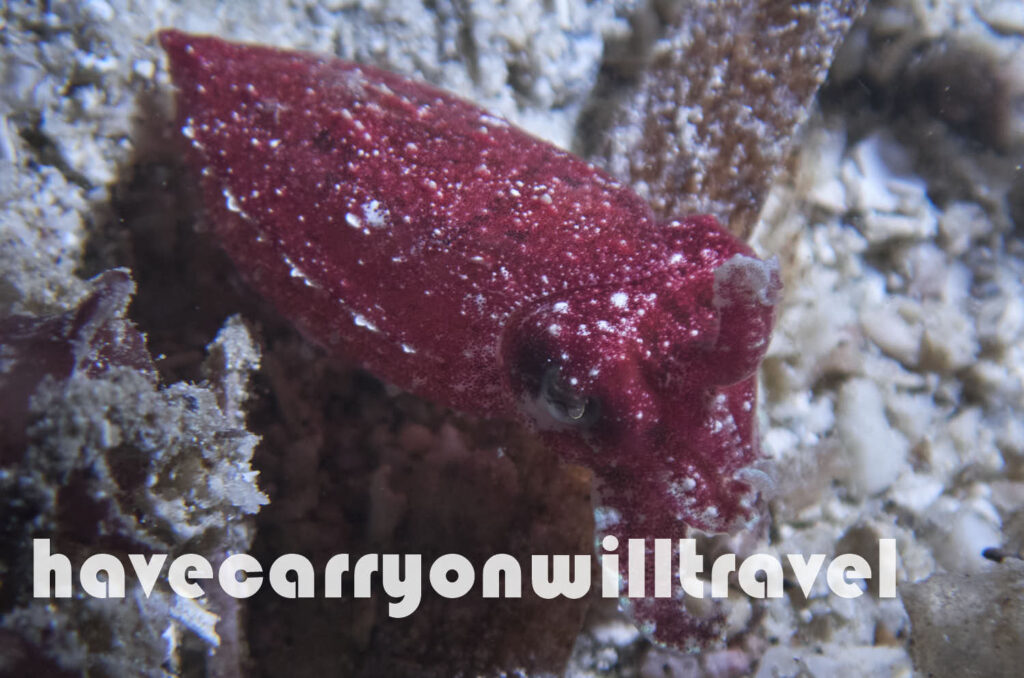If I have to describe, with one word, the diving here in Papua New Guinea, I would pick currents. We deal with currents on almost all the dives. It’s a double edged sword as currents are hard on air consumption but all the fish are in the current (as that is where the food is). The hard part is there are not too many drift dives. Most of the diving is off the back of the mother ship so you have to return to the back of the boat each dive. That means no matter how strong the current, we spend a good amount of time swimming into very fast moving water. The guides manage it as best they can but it still means some hard kicking and draining the tank quite quickly.

Most of the dives have an abundance of coral as the main backdrop, a couple of the dives have fissures running vertical through the coral gardens which makes for interesting terrain. There are a few dives on the south shore of New Britain that are starting to get covered in algae. Too bad, but there is always hope the reef will recover and the algae will retreat. Some dive sites sport huge, old sea fans, some elephant ears, most dives have soft and hard corals in abundance and some have many varieties of sponges, including gigantic barrels.

The diving is deep. We routinely descend down to 80, 90 or 100 feet, not our usual protocol but that’s where the big fish are. As the dive progresses we move higher up the reef towards our safety stop and as we ascend the smaller more colourful fish appear. We see massive schools of snappers, fusiliers, bannerfish and many others. Silvertip and grey reef sharks are in abundance. Nudibranchs on every dive give photo opportunities.

There are four dive guides and they rotate between the three dive groups. The groups are small, two groups of two and one of three divers. Each guide has his own style and we have to get used to all of them. They need to get used to us too! I decide very quickly which one is my fav. Our group has the three divers, Murray, B and me. B has 6000 dives and flits around by himself, Murray and I stick quite close together. Our group dives well together and do not get in each other’s way. Murray and I have close to 1000 dives and we are by far the newbies of this very experienced group. So even when all three groups start at the same time we all stay clear of one another.
The boat’s dive rules are a little more relaxed than other live a boards we have been on. Solo diving is accepted as long as you let the crew know. If you and your buddy want to go off alone with no guide that is OK as well, just make sure you can return to the boat. Deco dives are perfectly fine as long as you clear before getting back on the boat. Dive any depth as long as it is with the range of the Nitrox mix in your tank. It is asked that you do 5 minute safety stops no matter what your dive profile. Not a hard rule to adhere to. The idea is we are all certified divers and should be knowledgeable and careful enough to dive safely.

The dusk dive brings out a few creatures that do their wandering in the dark. One dive we come across a wonderpuss. A somewhat unusual eight armed creature in the octopus family. Other octopi are out for a walk as well. One of the dive guides finds a couple of mini cuttlefish. The muck diving, although not spectacular or a prolific as other place we have been, still has its share of unusual animals. One of Mur’s favourites is a tiny anemone crab. It is maybe 1/2″ wide and carrying two small anemones. One dive produces two snake eels buried in the sand, very ugly and scary looking beasts. Another highlight is on the very last dive when we found a very small juvi bat (spade) fish swimming in one of the I beam supports for a jetty.

Not many people go to PNG to dive so the reefs are in very good shape. There is an abundance of fish and many large schools. The reefs are not as spectacular as other places we have been but it was still worth the trip.

